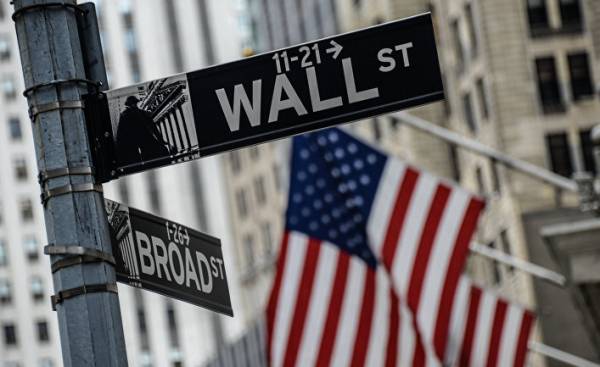
The increase in employment in America is 0.9%, and the increase in performance of 0.2%. Therefore physical limits of non-inflationary growth of the us economy today is estimated at a miserable 1.5 per cent.
The result is the acceleration of inflation in a slowing economy. Last year, the growth rate amounted to 1.6%, a full percentage point lower than in 2015. Despite this, core consumer prices increased 2.3% (from 1.9), the target rate of core inflation, the fed increased to 1.7% (from 1.0), and unit labor costs jumped to 2.6 % (from 2%).
With all that indicators of structural unemployment now represents 4.9%. This means that 15.2 million people do not currently have stable performance, will not be able to obtain it without serious structural changes in the labor market and goods.
This is a serious challenge for President trump. He can forget about a second term, which said last Saturday in the hangar Melbourne international airport in Florida, if you fail, quickly and significantly increase non-inflationary growth, to bring the work of these 15 million.
Don’t know exactly what he meant when he said that he inherited “a mess”, but the economy definitely is in this story, the main place. In addition, it is a structural mess, which should eliminate the structural policies, because they quickly increase the demand will fail.
The fed needs to monitor inflation
The fed can help the President to understand it correctly. State money managers could tell him that all this was done to support demand, output and employment in the economy experiencing a structural imbalance. But without help from the fiscal, structural and trade policies they will not be able to stop the reduction of human and physical capital and productivity.
For this reason, the potential (and non-inflationary) growth rate, which in 1990-e years at 3.2%, decreased to 1.5% and in the first decade of this century to 2.1%.
The above figures are the prices and the cost of labor clearly indicate that all the measures of support that the fed has to offer in the coming months, have their limits.
On fiscal policy, we I can not tell much, as the President said that in late March will present a program of taxation and spending. Until that time, we can only speculate regarding the scope and depth of these measures.
But to speculate about the severe constraints faced by fiscal policy, there is no need, since they are well known to us. The total amount of the budget deficit of the public sector is now around five percent of GDP; primary fiscal deficit (the deficit excluding interest service the existing public debt) equal to 1.5% of GDP; and public debt increasing rapidly and has exceeded 115% of GDP.
Looking at these numbers, the President could say, “What a mess!” In fact, these figures are very difficult to work with. But the President can lull the advice of aides who believe that a cakewalk, and that the deficit does not matter. They believe that America will come out of this at the expense of growth (inflation?).
What happened to “America first”?
These assistants may be right, but only under the condition that the Chinese, Europeans and Japanese to support our expansionist fiscal policy. They’re required to do, isn’t it? We provided them with a total active trade balance in the amount of 581 billion dollars, by purchasing from them in the past year goods to 1.1 trillion. And if these countries want us to keep spending money and kept their markets open, they’ll go for it. Or not?
Who knows? The President scared the hell out of all those German and Japanese parasites of the trade. They first rushed the first in the new York trump tower, and then to Washington, to see if understood correctly this a story about “America first”.
No wonder they’re scared. Look how they thank us. Japan last year had a surplus in trade with us in the amount of $ 69 billion, while selling Treasury securities amounting to 31.6 billion dollars. Germany received from us surplus in the trade balance in the amount of $ 65 billion, but bought our government bonds total 7.6 billion. They think they’ve gotten away with it? Not in front of the trump.
If you see all this fun trompowsky excerpt from the book “the Art to make deals”, that’s fine. But we must seriously treat the following. In the conditions of inflation and the budget that we have, that will increase pressure on our capital markets and appeals to Finance gigantic stimulus measures. In this situation, the fearful holders of Treasury securities took to their heels, and the growth in the stock market that began when trump, comes a crushing end.
Why? Because the fed can not cope with this. These people will surely raise interest rates, and believe the trite phrases that it will be done “gently and gradually”, it would be unwise. When the process of tightening liquidity picks up the pace, markets will start to wait for the next step, since the acceleration of the economy inflation is not reduced.
Structural policy and trade policy are equally complex, but the scope for action is much greater than in the field of financial and fiscal policy.
Reasonable measures of deregulation to enhance market efficiency can make a significant contribution to economic growth. Policy in the field of health, education and human resources is also very important for increasing the volume and improving the quality of human capital. This is an essential condition for improving labor productivity and potential economic growth. In addition, amendments to the tax code for corporations, as well as changes in unequal trade agreements are an important part of foreign policy.
Thoughts about investing
The American economy needs vast restructuring in the area of demand management, as well as a thorough structural and foreign trade policies to boost potential growth, which today is a measly half percent. This is a very difficult task that will require a lot of time and effort in light of the serious pending constraints of monetary and fiscal policy.
The only unknown in the equation is composed of the fed, is the rate and size of the increase in interest rates.
Planned tax cuts and spending programmes cannot but have a budgetary impact. And this creates serious risks for the financial markets, for economic growth and for employment growth, as the Federal reserve will not be able to meet the growing monetary needs of the Ministry of Finance with the same loan terms. Bond markets highly vulnerable. Stocks vulnerable to a lesser degree, but the portfolio will have to optimize at a price that is very difficult with tightening credit conditions.







